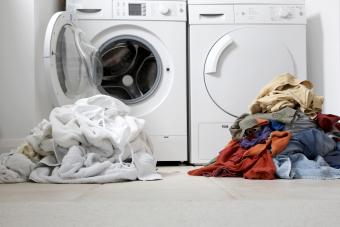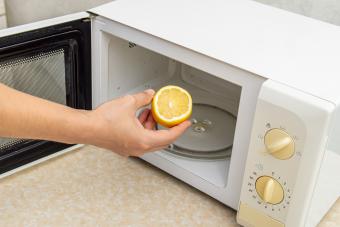
Laundry piles up fast. And if you have kids, those mounds of cloth and fabric grow faster than you can blink. That doesn't mean it needs to take over your life. Learn a few simple tips and tricks for how to separate and sort laundry fast.
Sorting Laundry Made Simple
You might be looking at that dirty laundry in the basket with apprehension. However, you can make this task easier with a little prep work. Set yourself up for laundry and adulting success. To get started, you need:
- Mesh bag
- Several baskets
- Stain fighter
Step 1: Laundry Color Guide
Start by sorting your clothes by color. Laundry organization tools, like divided hampers, work well to keep everything in the right pile. You can also designate a basket for whites, lights, and darks. If nothing else, create a pile on the floor. What's the difference between whites and lights? Get a quick breakdown of how to sort the colors.
White Clothes
These include all of your bright white socks, shirts, pants, etc. You typically use bleach in these loads to keep your whites bright. These will be mostly or all white. An example could be a collared white work shirt or a white towel.
Light Clothes
Lights are colors and pastels that you wouldn't consider white, but that aren't dark. These include your pale pink blouse or tan slacks. Are you wondering if gray is light or dark laundry? It depends on the gray. Light grays go with light clothes, while dark grays go with dark clothes.

Dark or Colored Clothes
Darks and colored clothing is easy to spot. These are the ones that are dark, like black, dark grey, purple, navy, green, and sometimes red. You also want to add brights to this pile, such as yellows, oranges, and reds. This includes multicolored clothing, even tie dye clothing. For example, a pair of flannel pants that are mostly navy and red with a bit of white. Though they have a little white in them, they still go in the darks and colored pile.
Step 2: Sort by Fabric Weight and Care Instructions
Once you've sorted your laundry into color groupings, you'll want to sort by fabric or weight. Think of this as sorting likes with likes. You can do this by checking the laundry symbol on each item. You can also feel the material. For example, cotton feels different and has a different weight than denim jeans or a polyester blouse. Sorting laundry this way ensures similar drying times and avoids damage to materials. Get a quick breakdown of the different types of materials and what they might include.

- Delicates - knits, lingerie, or fabrics that require gentle washing
- Cotton - T-shirts, leggings, and cotton blends with more than 50 percent cotton
- Polyester- shirts, blouses, and poly-blends with more than 50 percent polyester
- Jeans - jean material, pants, khakis, and other heavy materials
- Athletic wear - shorts, tanks, leggings, spandex, etc.
- Towels - towels, washcloths, hand towels
- Sheets - sheets, pillowcases, etc.
When sorting laundry by weight and material, you also want to think of things like shedding. Certain articles of clothing, such as sweaters, can shed, so you want to be sure to wash them separately.
Wash New Items Separately
Any new clothing, sheets, or towels should be washed separately, especially if they are bright or dark colors. This is because leftover dye sometimes will bleed out the first few times you wash them. Keep those off to the side and do them as they are received, so you don't accidentally mix them into your regular loads. Products like Shout Color Catchers are helpful additions that can keep clothes from bleeding, but you shouldn't rely on them to save a load of whites from a bright red shirt, or a load of yellows from new designer jeans.
Can You Wash Towels and Sheets Together?
While many people throw these household staples together into one load, they should be washed and dried separately. Towels stay fluffier when washed in hot cycles. Sheets should be done in warm cycles, not hot, due to shrinkage. Thick, heavy towels are considered rough when compared to more delicate sheet fabrics. Additionally, towels can cause lint buildup on sheets in the dryer. Finally, towels and sheets will dry at different rates, so they will not dry properly when done together.

Step 3: Sort by Soil Level
Now that you've separated out your colors and fabrics, you'll want to look for heavily soiled items. These are items with a lot of dirt, grime, sweat, and stains. For these items, do the following:
- Treat small stains using the method recommended for that stain type, whether it is ink, wine, food, or grass.
- Items with small, treated stains can be washed with the rest of the laundry in those piles.
- Items with lots of caked-on dirt, such as shirts worn to work in a barn, or that retain odors, such as cat bedding, should be separated out. These items should be washed together on the appropriate cleaning cycle.
Laundry Sorting Tips and Tricks
And that's the basics of sorting. See, learning how to properly do laundry isn't difficult. After a few times, it becomes second nature. But there are a few tips and tricks you can try to make things even easier.
- Label baskets and hampers by color or fabric so the whole family sorts as they discard their soiled clothing.
- Keep stain removal pre-treatments by the clothes baskets so items can be treated ahead of time. Make sure you purchase a treatment meant to sit for a few days.
- Don't throw bundles of clothes into the washer at once. Instead, pull each item out from the basket separately. This helps you find stray socks, underwear, and other items that were sorted into the wrong pile.
- Turn clothes inside out to protect them when washing.
- Put socks and delicates in a mesh bag to protect them and keep everything together.
- Wash the largest pile first and work your way down to the smallest. This helps you stay on top of your laundry.
- Sort laundry as you are taking it out of the rooms.
- Use the best laundry detergent for your load and washer.
- Keep items known to bleed, such as tie-dye shirts, out of the regular piles. Even when they have been washed a couple of times, certain fabrics and dyes may continue to bleed for several wash cycles. It's far easier to prevent a laundry mishap rather than remove color bleeding from clothes after the deed is done.
Laundry Sorting Made Simple
Set yourself up for laundry success by sorting your laundry before starting your next load. A little effort goes a long way toward producing excellent results. You'll save time and your favorite shirt!







